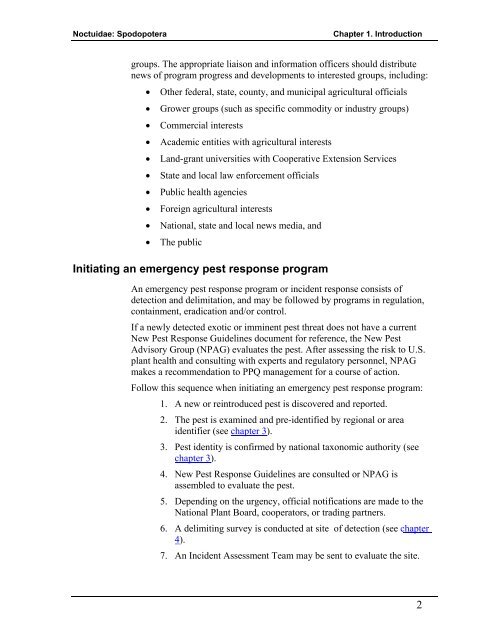New Pest Response Guidelines - Phytosanitary Resources
New Pest Response Guidelines - Phytosanitary Resources
New Pest Response Guidelines - Phytosanitary Resources
Create successful ePaper yourself
Turn your PDF publications into a flip-book with our unique Google optimized e-Paper software.
Noctuidae: Spodopotera<br />
Chapter 1. Introduction<br />
groups. The appropriate liaison and information officers should distribute<br />
news of program progress and developments to interested groups, including:<br />
• Other federal, state, county, and municipal agricultural officials<br />
• Grower groups (such as specific commodity or industry groups)<br />
• Commercial interests<br />
• Academic entities with agricultural interests<br />
• Land-grant universities with Cooperative Extension Services<br />
• State and local law enforcement officials<br />
• Public health agencies<br />
• Foreign agricultural interests<br />
• National, state and local news media, and<br />
• The public<br />
Initiating an emergency pest response program<br />
An emergency pest response program or incident response consists of<br />
detection and delimitation, and may be followed by programs in regulation,<br />
containment, eradication and/or control.<br />
If a newly detected exotic or imminent pest threat does not have a current<br />
<strong>New</strong> <strong>Pest</strong> <strong>Response</strong> <strong>Guidelines</strong> document for reference, the <strong>New</strong> <strong>Pest</strong><br />
Advisory Group (NPAG) evaluates the pest. After assessing the risk to U.S.<br />
plant health and consulting with experts and regulatory personnel, NPAG<br />
makes a recommendation to PPQ management for a course of action.<br />
Follow this sequence when initiating an emergency pest response program:<br />
1. A new or reintroduced pest is discovered and reported.<br />
2. The pest is examined and pre-identified by regional or area<br />
identifier (see chapter 3).<br />
3. <strong>Pest</strong> identity is confirmed by national taxonomic authority (see<br />
chapter 3).<br />
4. <strong>New</strong> <strong>Pest</strong> <strong>Response</strong> <strong>Guidelines</strong> are consulted or NPAG is<br />
assembled to evaluate the pest.<br />
5. Depending on the urgency, official notifications are made to the<br />
National Plant Board, cooperators, or trading partners.<br />
6. A delimiting survey is conducted at site of detection (see chapter<br />
4).<br />
7. An Incident Assessment Team may be sent to evaluate the site.<br />
2













